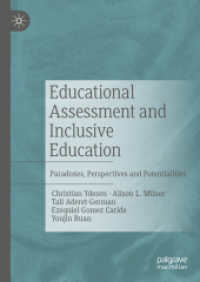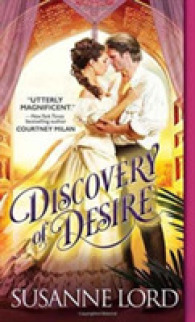- ホーム
- > 洋書
- > 英文書
- > Literary Criticism
Full Description
A collection of critical scholarship on early modern closet plays performed in private non-playhouse settings between 1560 and 1670. Capturing a lively period of performance, this volume covers textual history, women's writing and contemporary staging.
Scholars highlight the radical choices made by playwrights who were actively seeking to create a new theatre, distinct from the characteristics of the public stage. Studying a wide array of plays from 1560 to 1670, the book interrogates the role of women writers in the development of closet drama, early modern racialisation, translation and the circulation of particular motifs across the Channel. It pays close attention to Elizabeth Cary's The Tragedy of Mariam as a proto-feminist play that has become increasingly popular with teachers and directors. Contemporary performances of early modern closet plays such as Cleopatra, The Tragedy of Mariam, and Love's Victory are discussed through interviews with scholars involved in performance revivals. By offering an extensive and detailed exploration of closet drama readers are invited to rethink early modern theatre as a whole by looking beyond the public-private divide.
Contents
List of Illustrations
Contributors
Introduction by Aurélie Griffin (Sorbonne Nouvelle University, France) & Sophie Lemercier-Goddard (ENS de Lyon, France)
I. Plays for the Page?
1. Before Closet Drama: Periodization, Evidence, and the Non-Performance of Tudor Interludes, Patrick Durdel (University of Lausanne, Switzerland)
2. 'When perform'd / Wil this dull vow be?': George Chapman's Unstaged Plays, Christine Sukic (University of Reims, France)
II. Systems of Power
3. 'With all the ornaments on earth inrich'd': Power and Imagined Properties in Mary Sidney and Samuel Daniel's Cleopatra Plays, Daniel Cadman (Sheffield Hallam University, UK)
4. Race and the Christian Anatomy of Islam in Three Closet Dramas, Nora Galland (Côte d'Azur University, France)
III. Show and Tell in The Tragedy of Mariam
5. How to Do Things with Words: Learning and Teaching Rhetorics in The Tragedy of Mariam, Sophie Lemercier-Goddard (ENS de Lyon, France) and Aurélie Griffin (Sorbonne Nouvelle University, France)
6. 'Shows and proofs uneven': Evidence, Uncertainty and Women on Trial in The Tragedy of Mariam, Judith Hudson (Birkbeck College, University of London, UK)
7. 'All Passion Spent'?: Affective Worlds in Early Modern Closet Drama, Naya Tsentourou (University of Exeter, UK)
IV. Household Drama in the Cavendish circle
8. '[Our] brain, the stage': Oral and Silent Reading in Margaret Cavendish's Love's Adventure and The Convent of Pleasure, Line Cottegnies (Sorbonne University, France)
9. Rereading Elizabeth Brackley and Jane Cavendish's The Concealed Fancies as a Town Comedy, Marion Wynne-Davies (University of Surrey, UK)
V. Staging Closet Drama in the Twenty-First Century
10. Women's Closet Drama and Site-Specific Performances, Alison Findlay (Lancaster University, UK), Emma Rucastle (Director, ELART Productions) and Robert Crighton for the Beyond Shakespeare Podcast
11. Staging Samuel Daniel's Cleopatra (2013) and Elizabeth Cary's The Tragedy of Mariam (2022): Agency, Embodiment and Female Performance, Yasmin Arshad (University College London, UK), Emma Whipday (Newcastle University, UK), Bethany Mayo (Director, Baltimore Shakespeare Factory), Aurélie Griffin (Sorbonne University Nouvelle, France) and Sophie Lemercier-Goddard (ENS de Lyon, France)
Bibliography
Index







